NABUA, Camarines Sur — At night, Rosana Elmiñe and her fellow fisherfolk set out to sea to catch fish in Gubat town, Sorsogon province.
With nets in hand on a fishing boat, they navigate the waters in darkness. They only rely on the hope of a fruitful catch.
On some nights, Elmiñe and her companions use only flashlights as guides as they wade Gubat Bay searching for “semilya” or crab larvae–a significant part of their catch. Each small find is a step toward sustaining their families and preserving the livelihood they depend on.
Aside from the crab larvae and other crab species most of their catch were law-law, tamban, galunggong, and other typical varieties of fish offering a chance to sustain their families. They sell them at the market in the morning to make a modest living.
Elmiñe earns P150 to P300 a day from selling fish. Back then, the only problem they encountered was the unstable catch due to the changing season, but now their haul seems much smaller compared to what they caught in past years.
More than 150 families in Barangay Cota Na Daco in Gubat town rely on the sea for their livelihood, drawing sustenance and income from its resources.
Their way of life, however, is threatened by the construction of a coastal road spanning a three-kilometer section of Kalayukay Beach that straddles the villages of Balud del Norte, Cota na Daco, and Cogon.
“Napakalaki ng epekto ng coastal road natin diyan, ‘yong mga semilya ng alimango–ailien, angol, kasag—dito ka lang bumaba, meron na, pero ngayon ‘yong mga semilya ng alimango, wala na. Dahil ang putik at mga bato rin na nakatambak,” Elmiñe said.
(Our coastal road has a huge impact on that. If you just come down here, you’ll find the crab larvae. After they dumped silt and rocks, they’re gone.)
According to Ronaldo Macedonio, 62, coastal road projects had impacted their local livelihood, particularly crab farming, which relies on the natural environment.
He explained that they culture crabs in the area, and if the water warms due to the concrete project, crabs and other marine life like shells and fish won’t come near.
Although the coastal road project was halted in 2022 in Barangay Cota Na Daco, the presence of a nearby coastal road continues to cause impacts. Mud, silt, and rocks have kept the waters murky, making it difficult for fisherfolk to fully resume crab fishing.
“Malaki talaga ang epekto ng coastal road na kapag- naipatuloy yan, yung mga semilya ng mga alimango naman ang maapektuhan na siya namang pangkabuhayan ng mga tao dito. Doon nga sa bandang may mga mangrove puros baton a lang pano pa lalapi ang mga alimango kung puro bato. Kasi kinuculture naming yun e, kung maninit ang tubig at maraming bato pa diyan dahil sa coastal road wala ng lalapit dito na mga alimnago,” Macedonio shared.
(The coastal road really has a significant impact. If it continues, the crab larvae will be affected, which is the main livelihood of the people here. Over by the mangrove areas, it’s all just rocks; how can the crabs approach if it’s full of rocks? We culture them here, and if the water heats up and there’s more rocks because of the coastal road, no crabs will come near anymore.)
‘Build, Build, Build’
The Gubat Coastal Road is a project under the “Build, Build, Build” program of the previous Duterte administration. Funded by the national budget, it consists of two packages of road improvement and slope protection.
The P21.9-million first package includes road concreting and slope protection on an 831-square-meter section. The P74.6-million second package covers 2,143 square meters of slope protection to further reinforce the road.
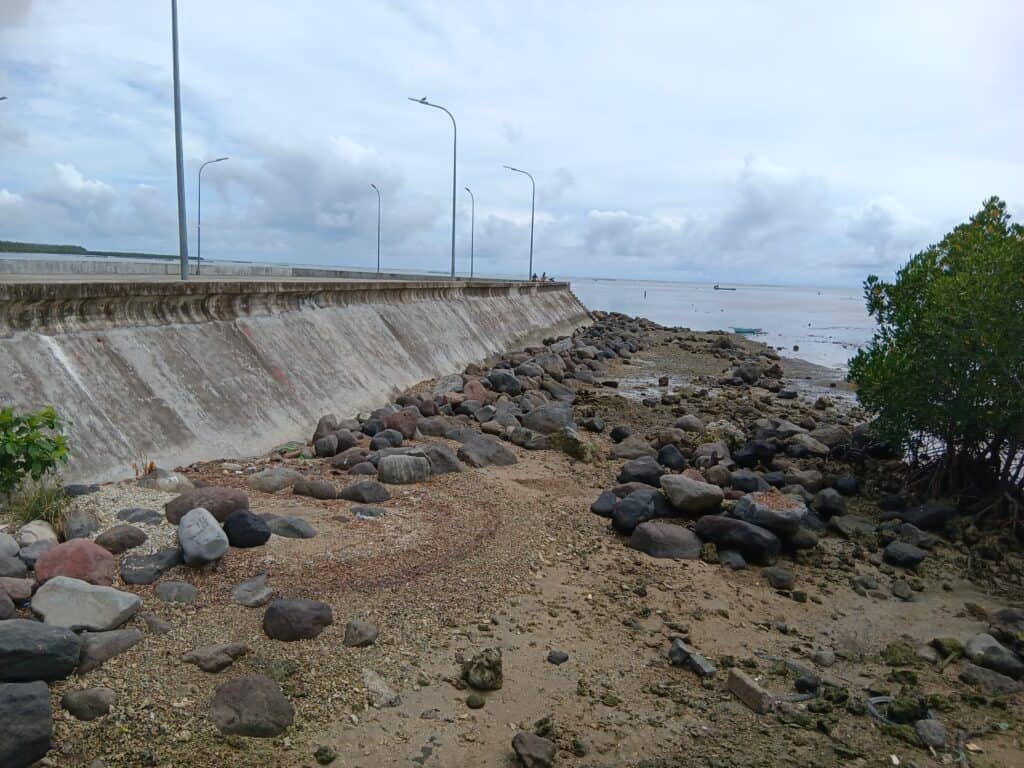
The municipality of Gubat sprawls on 5,431 hectares of land in the east coast of Sorsogon, famed for its fine beaches and “Butanding” or whale sharks. It faces the Pacific Ocean.
The project’s area is home to a rich and diverse ecosystem: 1,613 ha of seagrasses; 551.49 ha of mangrove forest; and 1,355.60 ha of coral reefs. The livelihood of more than 1,000 residents, including some 108 fishermen, is under threat.
Gubat is one of the country’s largest suppliers of king crab. Any decline in king crab larvae threatens both the local ecosystem and the economic stability of the town’s fishing industry.
Ernie Gallardo, leader of crablet gatherers in Barangay Cota Na Daco, believed that the dumping of soil may have destroyed the landmark identifying the breeding ground for king crab larvae.
Thus began the campaign by locals, fisherfolk, environmental advocates and civil society groups to stop a scenic coastline from being paved over, protecting a chunk of the ecosystem and the livelihood of families who depend on it.
In January 2022, the Save Gubat Bay Movement (SGBM) launched a petition against the road project in Gubat Bay, seeking help from then Vice President Leni Robredo and other officials, and linking up with fisherfolk, locals and groups.
Holding placards, they mounted a protest on the road, citing its harmful effects on the coastal ecosystem, particularly areas where sea turtles roost.
SGBM is a nonprofit established in 2013 to protect the environment and raise awareness about its possible abuse.
In March 2022, the Environmental Management Bureau (EMB) heeded their plea and issued a cease-and-desist order (CDO) against the project in Cota Da Naco.
But it didn’t stop there. In July 2023, SGBM wrote Environment Secretary Maria Antonia Yulo-Loyzaga to investigate road and reclamation projects that pose a threat to the ecosystems and communities in the bay.
In its letter, SGBM informed Loyzaga about the absence of dialogue between the government – specifically the project implementer, Department of Public Works and Highways (DPWH) – and the residents on the projects.
While the DPWH obtained a certificate of no objection from the Bureau of Fisheries and Aquatic Resources (BFAR) in Region 5, it failed to secure an environmental compliance certificate (ECC) from EMB for the road project.
SGBM president Allan Espallardo also said that BFAR could not provide information on the marine species threatened by the road project when they asked about it.
“Ayaw naming na dalhin ng susunod na henerasyon na kami ay inapi, api lamang, sa susunod na henerasyon, ang mga mangingisda, not in a way na manual na magingisda pwede naman Marine Biology, ganoon din ang makita nila na kaming mga nasa sektor ng mahihirap, mahirap pa rin kami dahil bakit? Kasi wala kami, sa politika wala kami sa gobyerno,” Espallardo added.
(“We don’t want the next generation to remember us as merely oppressed, just oppressed. In the next generation, fishermen should not only be seen as manual laborers but also as professionals like marine biologists. They should see that even though we come from the marginalized sector, we are still struggling. Why? Because we have no representation in politics, no voice in the government,” Espallardo added.)
On Aug. 27, 2023, SGBM organized a prayer rally after reports surfaced that dead corals were being used for the project’s construction.
Finally, on Oct. 6, 2023 the SGBM attended consultations with the Philippine Coast Guard, BFAR, and DPWH, demanding the permanent cancellation of the coastal road project.
Residents continue to feel the negative effects of the development.
“Malaki talaga ang epekto ng coastal road na kapag- naipatuloy yan, yung mga semilya ng mga alimango naman ang maapektuhan na siya namang pangkabuhayan ng mga tao dito. Doon nga sa bandang may mga mangrove puros baton a lang pano pa lalapi ang mga alimango kung puro bato. Kasi kinuculture naming yun e, kung maninit ang tubig at maraming bato pa diyan dahil sa coastal road wala ng lalapit dito na mga alimnago,” Macedonio said.
(“The coastal road has a significant impact. If it gets completed, the crab seedlings, which are the livelihood of the people here, will be affected. In the area with mangroves, it’s already mostly rocks. How can the crabs thrive if it’s all rocks? We culture them here, and if the water becomes too warm and there are more rocks because of the coastal road, no crabs will come here anymore,” Macedonio said.”)
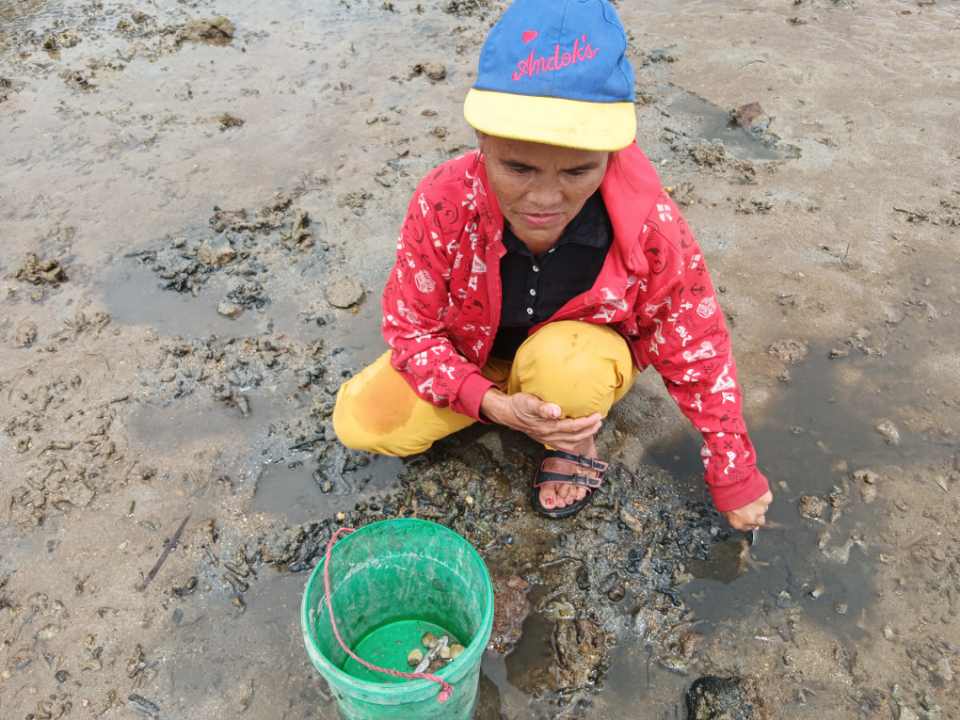
Gray and Green Infra
In Gubat, climate change-driven storm surges and rising sea levels are prompting engineers to rethink coastal development. Coastal roads and seawalls offer protection but raise concerns about environmental and social impacts.
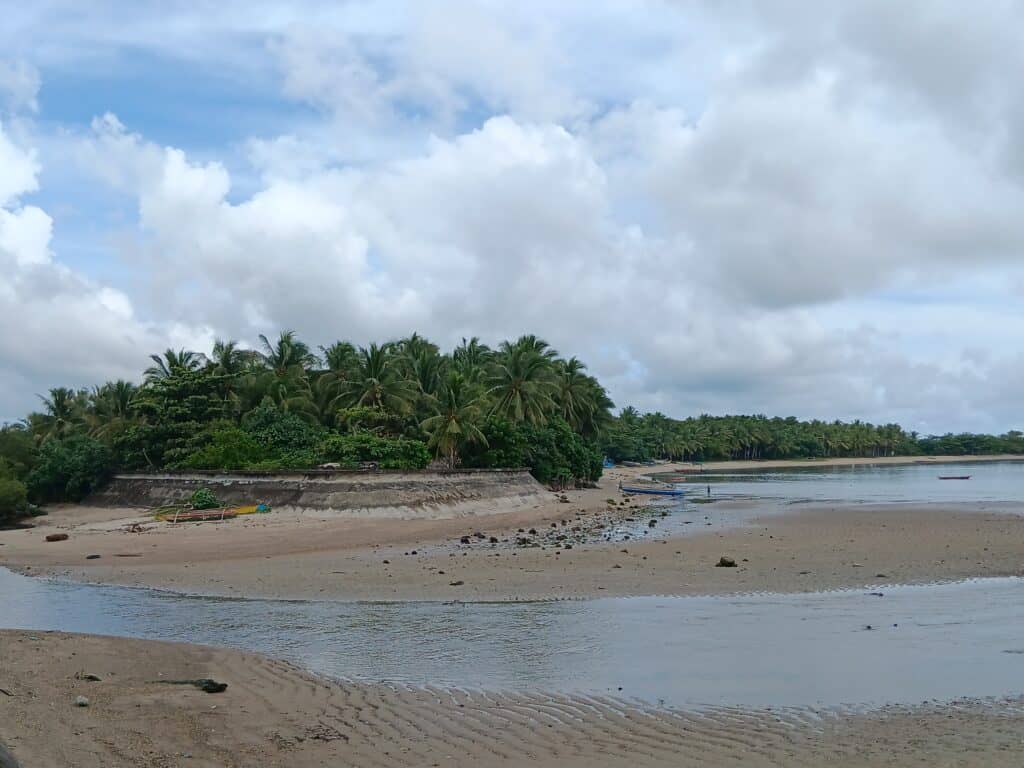
According to DPWH engineer Warren Gumabao, integrating mangroves and sea walls is an ideal blend of green and gray infrastructure. Mangroves help absorb wave energy, while sea walls provide a strong second line of defense.
The planning process comes with challenges, especially since some houses are built dangerously close to the shoreline.
“In these cases, we design infrastructure that prioritizes both safety and environmental preservation, but it requires weighing the immediate needs of people against long-term sustainability,” Gumabao said.
“It’s not just about protecting the present but also preparing for the future,” he added.
That’s why project developers must conduct environmental impact assessment and secure ECCs, said Ralph Chavez, EMB environmental specialist.
Surveying, community mobilization, and addressing opposition are prerequisites for any ECC approval, he said.
Since the DPWH has its own environmental section and the DENR-EMB only issues certificates, Chavez said project proponents should take full responsibility for ensuring the balanced implementation of the project.
“Without community consultation and proper documentation, projects cannot proceed,” he said.
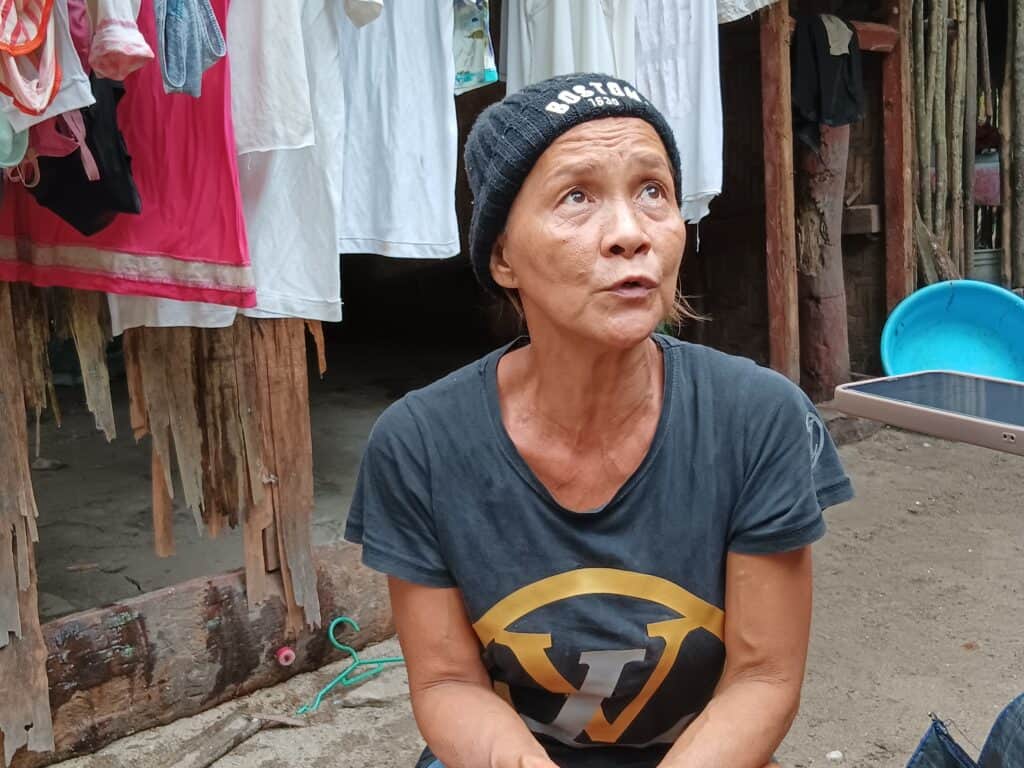
Eviction
Aside from the threats of coastal road projects, locals are fighting eviction from the land they’re living on in Barangay Cogon.
Agri party-list Rep. Wilbert Lee filed an eviction case against some members of the Kulag fisherman’s group in 28,473-square-meter land. In August this year, the Regional Trial Court (RTC) of Sorsogon dismissed the case.
The land in dispute is part of the Salvage Zone of the sea, an area along the shoreline that is typically designated for the preservation or recovery of land, often involving the management of natural resources. It is located 30 meters from the shoreline.
The residents believe they have the right to take care of the land where they planted coconut trees.
A video of a meeting in September this year showed Sorsogon Rep. Wowo Fortes urging the fisherfolk to give up their rights to the land. Fortes is an ally of Lee.
From 2018 until today, residents at Barangays Cogon and Cota Na Daco said they were harassed into accepting an offer of relocation from Fortes and local officials away from the sea and their livelihood at a stiff cost.
Rosana Elmine, 54, said the proposal to relocate them inland, with a steep mortgage on a supposed “free” house, is an unsustainable alternative.
“Di masampot iyong 15 thousand, kasi wara man kami pang-sustain,” she said.
(We can’t afford the P15,000 because we don’t have the means to sustain it.)
A resort is reportedly being planned to be built on the land.
Lee’s Agri party-list group advocates for the rights and welfare of farmers and fisherfolk as it promotes agriculture and supports other vulnerable sectors.
Bicoldotph reached out to Lee and Forets for comment, but they have yet to respond as of this writing.
Residents of Barangay Cogon, along with environmental groups, are calling on the local government and authorities to conduct a thorough investigation into the connection between LKY Corporation led by Lee to the continuous tensions and harassment to residents.
Elmiñe said: “Sana hayaan na lang nila kami, hayaan na mamuhay nang tahimik…may dignidad din naman kami, napatigil nga namin ang coastal project tapos ito na naman na private insfrastructure ang aming kalaban.”
(I hope they just leave us alone, let us live peacefully… we have dignity too, we were able to stop the coastal project, and now we are facing another private infrastructure.) Alliah Jane Babila
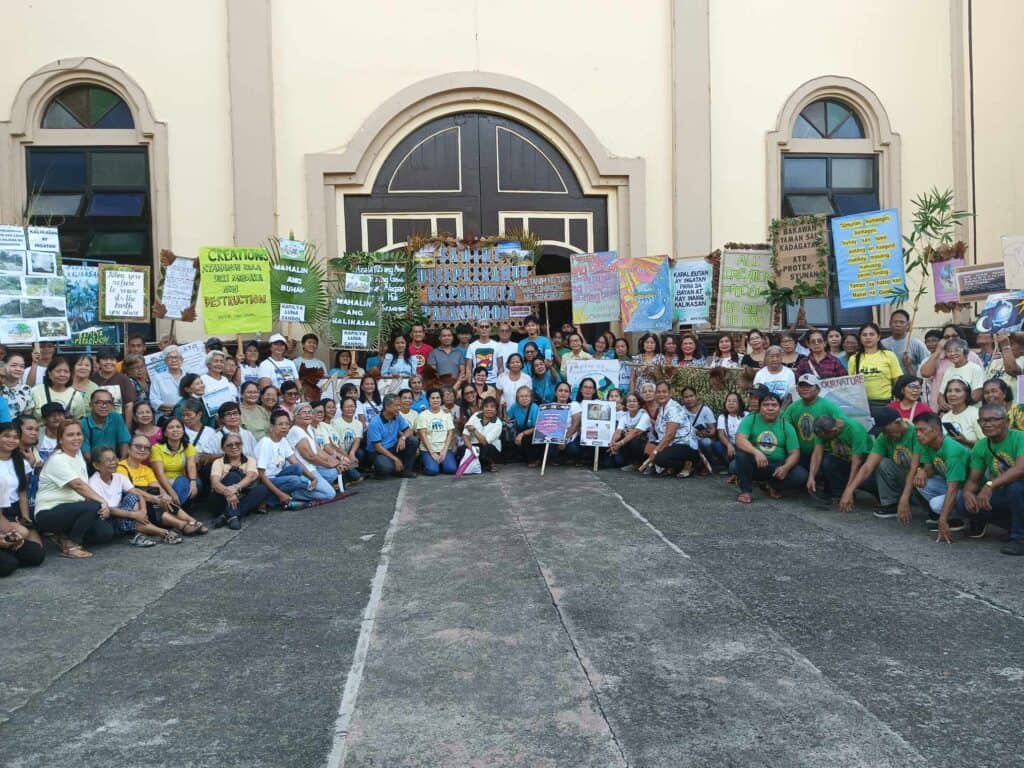
This story was produced with support of the Internews Earth Journalism Network.
